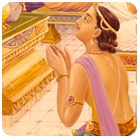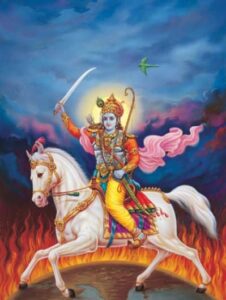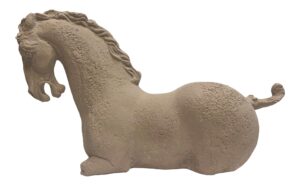Introduction to King Kulasekara
King Kulasekara was renowned for his virtues and capabilities:
- Administration: He was a strict and efficient administrator.
- Charisma: His countenance shone like the sun, and his heart was like a wish-fulfilling tree.
- Charity: He was extremely charitable.
- Learning: He was compared with Brihaspati in learning.
- Tolerance: He was as tolerant as Mother Earth.
- Beauty: He was as beautiful as Kamadeva.
- Purity: His mood and behavior were pure.
- Wealth: He was as wealthy as Kuvera.
Devotion and Daily Practice
Kulasekara was devoted to the devas and brahmanas, and he was constantly engaged in hearing and narrating Hari-katha (stories of Lord Hari).
The Incident with the Guru
One day, while the king was seated on his throne surrounded by ministers, soldiers, sadhus, and sanyasis listening to Hari-katha, his guru arrived. Kulasekara immediately left his throne, received his guru with reverence, offered prostrated obeisances, washed his lotus feet, and arranged a nice seat for him. By the order of his guru, the king also sat and continued listening to Hari-katha.
The Dust on the Forehead
While engrossed in the story, a fly came and sat on the king’s forehead. Feeling uncomfortable, he brushed his forehead to chase away the fly, causing some dust from his forehead, which had stuck there while paying obeisance to his guru, to fall to the ground.
Guru’s Reaction and the King’s Response
Noticing his guru’s apparent sadness, Kulasekara asked for the reason. The guru explained that when one offers prostrated obeisances to the guru, he is freed from the reaction of sinful activities for as many past lives as there are dust particles on his forehead. By removing the dust particles, the king had deprived himself of this purification.
Seeking Atonement
The king trembled and tears filled his eyes. He immediately sought advice from his ministers, sadhus, and brahmanas for atonement. Initially reluctant to tell him due to the difficulty of the atonement, they eventually revealed it:
The Atonement Process
The atonement required the king to perform a daunting task:
- Copper Plate: A copper plate, twelve feet long, three feet wide, and six inches thick, should be placed on four pillars with burning charcoal underneath until it became as hot as fire.
- Prostrated Obeisances: The king was to offer prostrated obeisances 108 times on the hot copper plate.
King Kulasekara’s Resolve
Despite the dangerous and painful nature of the atonement, King Kulasekara was jubilant at the opportunity to cleanse himself from the offense. He climbed onto the hot copper plate and began offering obeisances, feeling no pain.
Divine Intervention
As he continued, Lord Jagannath appeared before him, blessing the king and allowing him to complete his vow happily.
Spiritual Greed and Purification
This story emphasizes the importance of dust and association with divine personalities in spiritual purification. Just as the king sought atonement for his offense, devotees visiting holy places like Raman Reti in Gokulam, where Krishna played, often roll in the dust to become spiritually enriched.
Moral of the Story
The moral is that even the dust or mud in connection with divine personalities or places can significantly impact one’s karmic reactions. Devotion, humility, and the desire to cleanse oneself from offenses are paramount in spiritual life.
Hare Krishna, Hare Krishna, Krishna Krishna, Hare Hare
Hare Rama, Hare Rama, Rama Rama, Hare Hare
PS: I humbly request all devotees to please forward and share these moral/instructive stories they hear so that everyone can be benefited by hearing about Krishna and his dear devotees.



